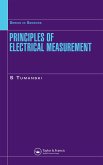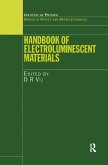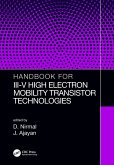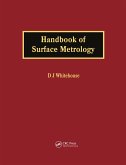Handbook of Moire Measurement (eBook, ePUB)
Redaktion: Walker, C. A.
62,95 €
62,95 €
inkl. MwSt.
Sofort per Download lieferbar

31 °P sammeln
62,95 €
Als Download kaufen

62,95 €
inkl. MwSt.
Sofort per Download lieferbar

31 °P sammeln
Jetzt verschenken
Alle Infos zum eBook verschenken
62,95 €
inkl. MwSt.
Sofort per Download lieferbar
Alle Infos zum eBook verschenken

31 °P sammeln
Handbook of Moire Measurement (eBook, ePUB)
Redaktion: Walker, C. A.
- Format: ePub
- Merkliste
- Auf die Merkliste
- Bewerten Bewerten
- Teilen
- Produkt teilen
- Produkterinnerung
- Produkterinnerung

Bitte loggen Sie sich zunächst in Ihr Kundenkonto ein oder registrieren Sie sich bei
bücher.de, um das eBook-Abo tolino select nutzen zu können.
Hier können Sie sich einloggen
Hier können Sie sich einloggen
Sie sind bereits eingeloggt. Klicken Sie auf 2. tolino select Abo, um fortzufahren.

Bitte loggen Sie sich zunächst in Ihr Kundenkonto ein oder registrieren Sie sich bei bücher.de, um das eBook-Abo tolino select nutzen zu können.
Since its development in the late 1970s, the Moire Fringe method has become a standard technique for the measurement of the behavior of materials and structures. Edited by one of the co-inventors of the technique, the Handbook of Moire Measurement brings together a series of extended case studies from recognized experts in the field. The emphasis i
- Geräte: eReader
- mit Kopierschutz
- eBook Hilfe
Andere Kunden interessierten sich auch für
![Principles of Electrical Measurement (eBook, ePUB) Principles of Electrical Measurement (eBook, ePUB)]() Slawomir TumanskiPrinciples of Electrical Measurement (eBook, ePUB)62,95 €
Slawomir TumanskiPrinciples of Electrical Measurement (eBook, ePUB)62,95 €![Physics for Technology, Second Edition (eBook, ePUB) Physics for Technology, Second Edition (eBook, ePUB)]() Daniel H. NicholsPhysics for Technology, Second Edition (eBook, ePUB)46,95 €
Daniel H. NicholsPhysics for Technology, Second Edition (eBook, ePUB)46,95 €![Portable Biosensing of Food Toxicants and Environmental Pollutants (eBook, ePUB) Portable Biosensing of Food Toxicants and Environmental Pollutants (eBook, ePUB)]() Portable Biosensing of Food Toxicants and Environmental Pollutants (eBook, ePUB)45,95 €
Portable Biosensing of Food Toxicants and Environmental Pollutants (eBook, ePUB)45,95 €![Handbook of Electroluminescent Materials (eBook, ePUB) Handbook of Electroluminescent Materials (eBook, ePUB)]() Handbook of Electroluminescent Materials (eBook, ePUB)316,95 €
Handbook of Electroluminescent Materials (eBook, ePUB)316,95 €![Semiconductor Radiation Detectors (eBook, ePUB) Semiconductor Radiation Detectors (eBook, ePUB)]() Alan OwensSemiconductor Radiation Detectors (eBook, ePUB)51,95 €
Alan OwensSemiconductor Radiation Detectors (eBook, ePUB)51,95 €![Handbook for III-V High Electron Mobility Transistor Technologies (eBook, ePUB) Handbook for III-V High Electron Mobility Transistor Technologies (eBook, ePUB)]() Handbook for III-V High Electron Mobility Transistor Technologies (eBook, ePUB)51,95 €
Handbook for III-V High Electron Mobility Transistor Technologies (eBook, ePUB)51,95 €![Handbook of Surface Metrology (eBook, ePUB) Handbook of Surface Metrology (eBook, ePUB)]() David J. WhitehouseHandbook of Surface Metrology (eBook, ePUB)875,95 €
David J. WhitehouseHandbook of Surface Metrology (eBook, ePUB)875,95 €-
-
-
Since its development in the late 1970s, the Moire Fringe method has become a standard technique for the measurement of the behavior of materials and structures. Edited by one of the co-inventors of the technique, the Handbook of Moire Measurement brings together a series of extended case studies from recognized experts in the field. The emphasis i
Dieser Download kann aus rechtlichen Gründen nur mit Rechnungsadresse in A, B, BG, CY, CZ, D, DK, EW, E, FIN, F, GR, HR, H, IRL, I, LT, L, LR, M, NL, PL, P, R, S, SLO, SK ausgeliefert werden.
Produktdetails
- Produktdetails
- Verlag: Taylor & Francis eBooks
- Seitenzahl: 501
- Erscheinungstermin: 1. Dezember 2003
- Englisch
- ISBN-13: 9781000687408
- Artikelnr.: 57530962
- Verlag: Taylor & Francis eBooks
- Seitenzahl: 501
- Erscheinungstermin: 1. Dezember 2003
- Englisch
- ISBN-13: 9781000687408
- Artikelnr.: 57530962
- Herstellerkennzeichnung Die Herstellerinformationen sind derzeit nicht verfügbar.
CA Walker Department of Mechanical Engineering, University of Strathclyde, UK
1 Introduction
1.1 A brief history of the moiré method
References
CHAPTER 2: STRAIN MEASUREMENTS AT THE LIMIT-THE MOIRÉ MICROSCOPE
2.1 Nonlinear analysis of interferometric moiré fringes
2.1.1 Example fringe data reduction
References
2.2 Microscopic moiré interferometry
2.2.1 Immersion interferometer
2.2.1.1 Optical configuration
2.2.1.2 Four-beam immersion interferometer
2.2.2 Mechanical configuration
2.2.3 Fringe shifting and O/DFM method
References
2.3 Localized thermal strains in electronic interconnections by microscopic moiré interferometry
2.3.1 Specimen preparation
2.3.2 Thin small outline package
2.3.3 Leadless chip carrier
2.3.4 Effect of underfill encapsulation on flip chip solder bump
2.3.5 Plated through hole
References
2.4 Titanium in elastic tension: micromechanical deformation
2.4.1 Introduction
2.4.2 Specimen and loading fixture
2.4.3 Experimental procedure and fringe patterns
2.4.4 Anomalous strains along the grain boundaries
2.4.5 Discussion
References
2.5 Micromechanical thermal deformation of unidirectional boron/aluminum composite
2.5.1 Experimental procedure and fringe patterns
2.5.2 Analysis and results
2.5.3 Discussion
References
CHAPTER 3: FRACTURE MECHANICS
3.1.1 Assessment of the shape of crack-tip plastic zones as a function of applied load
3.1.1.1 Introduction
3.1.1.2 Experimental details
3.1.1.3 Measurement of Von Mises yield locus
3.1.1.4 Discussion of results
3.1.1.5 Conclusions
References
3.1.2 Deformation around fatigue cracks from moiré fringe measurement
3.1.2.1 Introduction
3.1.2.2 Basic crack-tip models
3.1.2.2.1 Stationary crack under monotonie loading
3.1.2.2.2 Stationary crack under cyclic loading
3.1.2.3 Experimental details
3.1.2.4 Fatigue crack-tip deformation
3.1.2.4.1 Local yielding
3.1.2.4.2 Non-singular stresses
3.1.2.4.3 Cyclic plasticity
3.1.2.4.4 Local mode-mixity
3.1.2.5 Summary
Acknowledgment
References
3.2.1 Applications of moiré to cellulosic (paper and woo
1.1 A brief history of the moiré method
References
CHAPTER 2: STRAIN MEASUREMENTS AT THE LIMIT-THE MOIRÉ MICROSCOPE
2.1 Nonlinear analysis of interferometric moiré fringes
2.1.1 Example fringe data reduction
References
2.2 Microscopic moiré interferometry
2.2.1 Immersion interferometer
2.2.1.1 Optical configuration
2.2.1.2 Four-beam immersion interferometer
2.2.2 Mechanical configuration
2.2.3 Fringe shifting and O/DFM method
References
2.3 Localized thermal strains in electronic interconnections by microscopic moiré interferometry
2.3.1 Specimen preparation
2.3.2 Thin small outline package
2.3.3 Leadless chip carrier
2.3.4 Effect of underfill encapsulation on flip chip solder bump
2.3.5 Plated through hole
References
2.4 Titanium in elastic tension: micromechanical deformation
2.4.1 Introduction
2.4.2 Specimen and loading fixture
2.4.3 Experimental procedure and fringe patterns
2.4.4 Anomalous strains along the grain boundaries
2.4.5 Discussion
References
2.5 Micromechanical thermal deformation of unidirectional boron/aluminum composite
2.5.1 Experimental procedure and fringe patterns
2.5.2 Analysis and results
2.5.3 Discussion
References
CHAPTER 3: FRACTURE MECHANICS
3.1.1 Assessment of the shape of crack-tip plastic zones as a function of applied load
3.1.1.1 Introduction
3.1.1.2 Experimental details
3.1.1.3 Measurement of Von Mises yield locus
3.1.1.4 Discussion of results
3.1.1.5 Conclusions
References
3.1.2 Deformation around fatigue cracks from moiré fringe measurement
3.1.2.1 Introduction
3.1.2.2 Basic crack-tip models
3.1.2.2.1 Stationary crack under monotonie loading
3.1.2.2.2 Stationary crack under cyclic loading
3.1.2.3 Experimental details
3.1.2.4 Fatigue crack-tip deformation
3.1.2.4.1 Local yielding
3.1.2.4.2 Non-singular stresses
3.1.2.4.3 Cyclic plasticity
3.1.2.4.4 Local mode-mixity
3.1.2.5 Summary
Acknowledgment
References
3.2.1 Applications of moiré to cellulosic (paper and woo
1 Introduction
1.1 A brief history of the moiré method
References
CHAPTER 2: STRAIN MEASUREMENTS AT THE LIMIT-THE MOIRÉ MICROSCOPE
2.1 Nonlinear analysis of interferometric moiré fringes
2.1.1 Example fringe data reduction
References
2.2 Microscopic moiré interferometry
2.2.1 Immersion interferometer
2.2.1.1 Optical configuration
2.2.1.2 Four-beam immersion interferometer
2.2.2 Mechanical configuration
2.2.3 Fringe shifting and O/DFM method
References
2.3 Localized thermal strains in electronic interconnections by microscopic moiré interferometry
2.3.1 Specimen preparation
2.3.2 Thin small outline package
2.3.3 Leadless chip carrier
2.3.4 Effect of underfill encapsulation on flip chip solder bump
2.3.5 Plated through hole
References
2.4 Titanium in elastic tension: micromechanical deformation
2.4.1 Introduction
2.4.2 Specimen and loading fixture
2.4.3 Experimental procedure and fringe patterns
2.4.4 Anomalous strains along the grain boundaries
2.4.5 Discussion
References
2.5 Micromechanical thermal deformation of unidirectional boron/aluminum composite
2.5.1 Experimental procedure and fringe patterns
2.5.2 Analysis and results
2.5.3 Discussion
References
CHAPTER 3: FRACTURE MECHANICS
3.1.1 Assessment of the shape of crack-tip plastic zones as a function of applied load
3.1.1.1 Introduction
3.1.1.2 Experimental details
3.1.1.3 Measurement of Von Mises yield locus
3.1.1.4 Discussion of results
3.1.1.5 Conclusions
References
3.1.2 Deformation around fatigue cracks from moiré fringe measurement
3.1.2.1 Introduction
3.1.2.2 Basic crack-tip models
3.1.2.2.1 Stationary crack under monotonie loading
3.1.2.2.2 Stationary crack under cyclic loading
3.1.2.3 Experimental details
3.1.2.4 Fatigue crack-tip deformation
3.1.2.4.1 Local yielding
3.1.2.4.2 Non-singular stresses
3.1.2.4.3 Cyclic plasticity
3.1.2.4.4 Local mode-mixity
3.1.2.5 Summary
Acknowledgment
References
3.2.1 Applications of moiré to cellulosic (paper and woo
1.1 A brief history of the moiré method
References
CHAPTER 2: STRAIN MEASUREMENTS AT THE LIMIT-THE MOIRÉ MICROSCOPE
2.1 Nonlinear analysis of interferometric moiré fringes
2.1.1 Example fringe data reduction
References
2.2 Microscopic moiré interferometry
2.2.1 Immersion interferometer
2.2.1.1 Optical configuration
2.2.1.2 Four-beam immersion interferometer
2.2.2 Mechanical configuration
2.2.3 Fringe shifting and O/DFM method
References
2.3 Localized thermal strains in electronic interconnections by microscopic moiré interferometry
2.3.1 Specimen preparation
2.3.2 Thin small outline package
2.3.3 Leadless chip carrier
2.3.4 Effect of underfill encapsulation on flip chip solder bump
2.3.5 Plated through hole
References
2.4 Titanium in elastic tension: micromechanical deformation
2.4.1 Introduction
2.4.2 Specimen and loading fixture
2.4.3 Experimental procedure and fringe patterns
2.4.4 Anomalous strains along the grain boundaries
2.4.5 Discussion
References
2.5 Micromechanical thermal deformation of unidirectional boron/aluminum composite
2.5.1 Experimental procedure and fringe patterns
2.5.2 Analysis and results
2.5.3 Discussion
References
CHAPTER 3: FRACTURE MECHANICS
3.1.1 Assessment of the shape of crack-tip plastic zones as a function of applied load
3.1.1.1 Introduction
3.1.1.2 Experimental details
3.1.1.3 Measurement of Von Mises yield locus
3.1.1.4 Discussion of results
3.1.1.5 Conclusions
References
3.1.2 Deformation around fatigue cracks from moiré fringe measurement
3.1.2.1 Introduction
3.1.2.2 Basic crack-tip models
3.1.2.2.1 Stationary crack under monotonie loading
3.1.2.2.2 Stationary crack under cyclic loading
3.1.2.3 Experimental details
3.1.2.4 Fatigue crack-tip deformation
3.1.2.4.1 Local yielding
3.1.2.4.2 Non-singular stresses
3.1.2.4.3 Cyclic plasticity
3.1.2.4.4 Local mode-mixity
3.1.2.5 Summary
Acknowledgment
References
3.2.1 Applications of moiré to cellulosic (paper and woo







